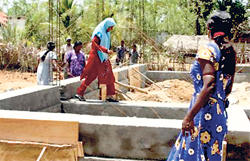Disasters destroy and disrupt. Yet, a disaster can recreate and reconstruct. It can bring opportunities for people to rebuild their lives in ways that reconfigure social relationships. It can, for example, empower women. The December 2004 tsunami was no exception.
T. Rufia from Kalmunai, a 32-year-old mother of two girls, faced the challenge of the tsunami single-handedly, with her husband in the safer confines of a prison. Her house collapsed, but she and her children were unharmed. When the government gave her Rs. 250, 000 to build a new home, she knew it would not be enough, but focused on establishing a firm foundation for the family she is responsible for.
Even two years after the tsunami, tens of thousands of families in Sri Lanka were living in partially-built houses because the government grant they received fell short. This was when several agencies came forward to provide ‘top-up’ grants to help people restart from where they were forced to stop. In the Ampara district, UN-HABITAT collaborated with Norwegian People’s Aid (NPA) and the Solidar INGO Consortium to help 475 families complete their homes, rebuild damaged community infrastructure, and improve livelihoods.
 |
| Rebuilding lives : Women are very much a part of community construction activities |
Rebuilding Community Infrastructure and Shelter (RCIS) is a project that uses the key mechanisms of Community Development Councils (CDCs) and Community Action Planning (CAP) to ensure that people are well represented and active participants in their own development. CDCs identify and prioritize critical issues, plan action, implement activities and monitor work. In fact, money for all construction, capacity building and livelihood development activities is channelled through them.
Setting up the CDCs, however, is a complicated process. But, as Rufia points out, it is also an empowering one, both for the community and for individuals: “First, we needed to register the CDC with the local authorities. As its Secretary, I went with a few other office bearers to the Divisional Secretary’s office to get this done. I then took on the responsibility of opening a bank account for the CDC. It was not an easy task because I had not done this before. Besides, no one took us seriously. Today it’s a different story. They treat us with respect. We manage millions of rupees through this account.”
In many areas of the country, socially and culturally imposed restrictions to women’s mobility and social contact limit their access to information and undermine their confidence. Rufia is happy that she can now deal easily with banks and other institutions. After a year of being the CDC Secretary, she stepped down to let another member take up her position: “This is the policy of our CDC. When we are office bearers, we gain a lot of experience and we feel we should also give others a chance.”
With the Rs. 350,000 rupees she received in instalments from the RCIS project, Rufia completed her house.
 |
| Rufia with her daughters |
Kadija Umma, a mother of three, took almost four years to build her new home: "I was in debt, but used every cent of the 200,000 rupees I got from the government to build one room and part of the roof. When I got the money from UN-HABITAT, I got some good technical advice as well.
I decided not to use asbestos sheeting for the roof and made my windows larger. So I've built a solid house that is good to live in. And the CDC was always there to help out."
She values the fact that her home is "owner-driven", that it incorporates her basic requirements, including some improvements suggested by the technical officers: "I was very much part of the process of building my home. Now that I've built it, I can think of other things." |


